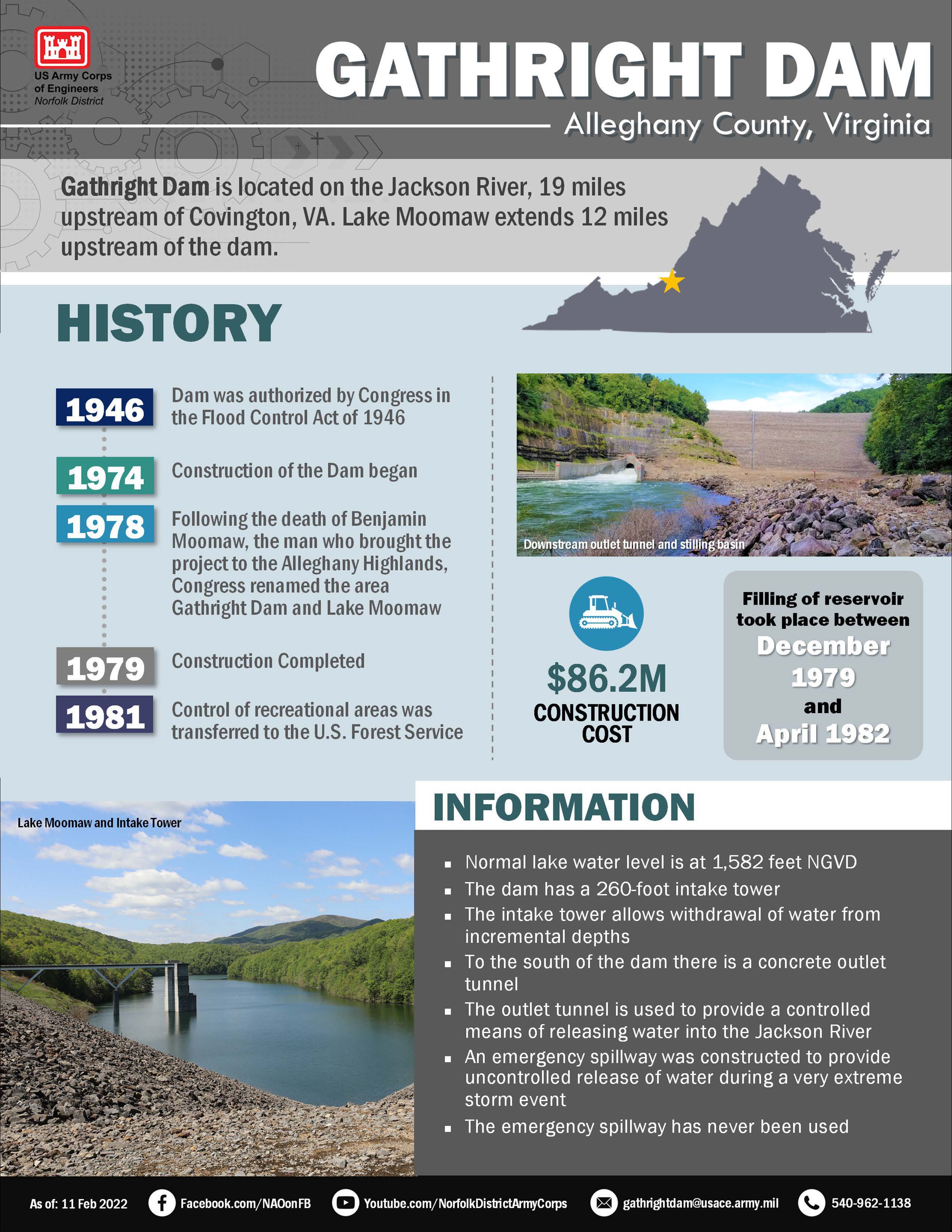 PROJECT SCOPE: The Gathright Dam and Lake Moomaw Project provides flood protection of industrial, commercial and residential properties along the Jackson and James rivers with immediate impact on Covington, Virginia.
PROJECT SCOPE: The Gathright Dam and Lake Moomaw Project provides flood protection of industrial, commercial and residential properties along the Jackson and James rivers with immediate impact on Covington, Virginia.
AUTHORIZATION: Flood Control Act of 1946.
BACKGROUND: The dam is a rolled-rock fill embankment with a compacted earthen-clay core, outlet works and an emergency spillway located at the right abutment. The embankment is 1,310 feet long with a height of 257 feet. The width is 32 feet at the top of the dam with a maximum width of 1,000 feet at its base. Dam construction began in 1974 and was completed in 1979. Water impoundment began in December 1979 and was completed in April 1982.
The Gathright Dam and Lake Moomaw project is located 43 miles above the confluence of the Jackson and James Rivers and 17 miles upstream of Covington, Virginia. The Lake Moomaw reservoir was authorized by Congress through the Flood Control act of 1946. The clearing of the land that would later become Lake Moomaw began in 1967. Construction of the earthen portion of the dam was started in 1974. The United States Army Corps of Engineers (USACE) completed construction of the dam in 1979 and initial filling was completed in 1982. Lake Moomaw is 12 miles long and covers 2,530 acres with 43.5 miles of shoreline. The lake has an average depth of 80 feet with the deepest point being 150 feet at the intake tower at normal pool. The height of the dam is 257 feet. The length of Gathright dam is 1,310 feet long with the width of the crest being 32 feet wide. A state-maintained road runs across the top of the dam. The project reduces flood damages along the Jackson and James Rivers during large storm events, stores rainfall from late winter through early summer to augment flow during the drier late summer/early autumn months and provides for water-based recreation. The dam consists of a large rock-filled embankment, water intake tower, reinforced concrete outlet pipe, and an uncontrolled earth spillway located about two miles south of the dam. The US Army Corps of Engineers manages approximately 250 acres of land associated with the project. Key maintenance areas of the project include the earthen portion of the dam, the intake tower which manages the outflows, a portion of the river directly below the dam as well as several small buildings that support U.S. Forest Service recreation areas. All recreation and camping areas were conveyed to the U.S. Forest Service in 1981. Lastly, at normal pool the dam is holding back approximately 40 billion gallons of water and has the capacity to hold up to 137 billion gallons. During extraordinary events the water is designed to be released via a spillway. This has never occurred.
As part of Norfolk District's comprehensive dam safety program, Gathright Dam has been inspected and monitored closely since it became operational in 1979. The dam's instrumentation monitors seepage, piezometric levels (internal seepage pressure), and horizontal and vertical movements of the dam crest. The dam is regularly inspected by facility staff, as well as Norfolk District engineers. Facility personnel inspect the dam daily under normal operating conditions and more frequently during high-pool levels. Norfolk District engineers inspect the dam at least annually, with more intensive team inspections every five years through the USACE Dam Safety Program.
The pool of record elevation is 1,598.4 feet, reached Jan. 20, 1996. The lake's normal pool conservation is 1,582 feet above sea level.